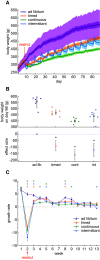Three Water Restriction Schedules Used in Rodent Behavioral Tasks Transiently Impair Growth and Differentially Evoke a Stress Hormone Response without Causing Dehydration
- PMID: 34815297
- PMCID: PMC8672445
- DOI: 10.1523/ENEURO.0424-21.2021
Three Water Restriction Schedules Used in Rodent Behavioral Tasks Transiently Impair Growth and Differentially Evoke a Stress Hormone Response without Causing Dehydration
Abstract
Water restriction is commonly used to motivate rodents to perform behavioral tasks; however, its effects on hydration and stress hormone levels are unknown. Here, we report daily body weight and bi-weekly packed red blood cell volume and corticosterone (CORT) in adult male rats across 80 days for three commonly used water restriction schedules. We also assessed renal adaptation to water restriction using postmortem histologic evaluation of renal medulla. A control group received ad libitum water. After one week of water restriction, rats on all restriction schedules resumed similar levels of growth relative to the control group. Normal hydration was observed, and water restriction did not drive renal adaptation. An intermittent restriction schedule was associated with an increase in CORT relative to the control group. However, intermittent restriction evokes a stress response which could affect behavioral and neurobiological results. Our results also suggest that stable motivation in behavioral tasks may only be achieved after one week of restriction.
Copyright © 2021 Vasilev et al.
Figures




References
-
- Barnet RC, Cole RP, Miller RR (1997) Temporal integration in second-order conditioning and sensory preconditioning. Anim Learn Behav 25:221–233. 10.3758/BF03199061 - DOI
Publication types
MeSH terms
Substances
LinkOut - more resources
Full Text Sources
Medical
